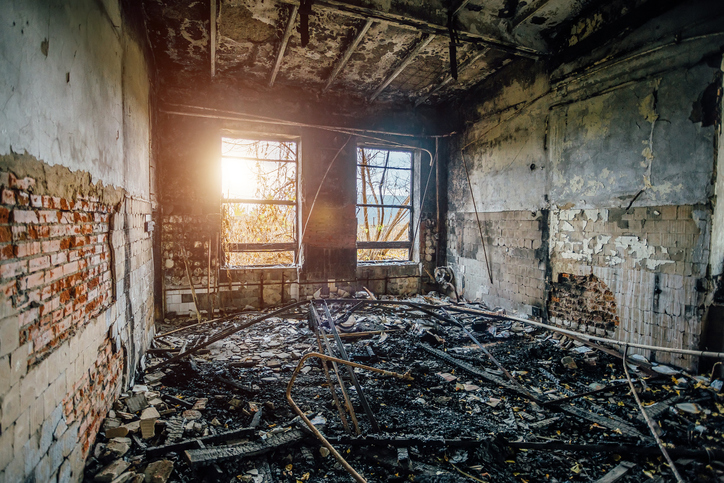The importance of ‘Uninsured Risks’ in leases
Real Estate Associate Gaye King looks into the unusual, but important, concept of “uninsured risks” in commercial leases.
Insured Risks
Landlords are usually obliged to insure the property/building that they let to tenants, for which the tenants will pay a contribution towards the cost of the premiums for such insurance. If the landlord owns a building/estate made up of several units then it makes complete sense for the landlord to insure, so that they can ensure that there is adequate and uniform cover in place to protect their freehold (or long leasehold) interest, preserving the value of their investment and making a saving through block purchasing. Cover can differ, but usual insured risks include fire, explosions, storm, tempest, riot etc.
In a standard lease where the tenant is required to keep the property in good and substantial repair and condition, there is usually a provision that damage caused by an insured risk is excluded from that. This means that in the event of the property being damaged by an insured risk the tenant will not be required to repair the damage, but the landlord would reinstate. It would be unfair for the tenant to pay the insurance premiums and then to still have to repair at its own cost. It is also usual for the obligation to pay rent to be suspended from the date of damage by an insured risk until the date the property has been reinstated: the landlord still gets its money from a “loss of rent” policy, that the tenants pay the premiums for.
You may find that where the lease is of a part of the landlord’s building, then the landlord is likely to be able to recover their costs of repairing the structure of the building/common parts where they are damaged by an uninsured risk by way of a service charge demand.
Uninsured Risks
This became a hot topic in the 1990’s, when repeated IRA bombings on the British mainland made the property industry very jittery that the insurance market might fail, and property lawyers got their drafting pens out. It can also be an issue on river or sea flood plains, particularly as weather extremes seem to be more and more frequent.
Generally, it arises with normally-insured risks that the market will no longer cover, rather than exceptional or obscure risks that are usually outside the list of a usual property-owners’ policy. If the insurers no longer cover a certain type of damage (such as terrorism), then this would often be classed an “uninsured risk”. There may be times when a certain risk cannot be covered due to a policy exclusion or limitation or because insurance is not commercially available.
Leases can be silent on what the procedure is if the property is damaged by a risk which the landlord has not insured or cannot insure for e.g. terrorism and flooding. Outside of big cities or flood zones, you may ask is it worth the worry? However, if the lease does not provide for this eventuality, then the tenant will be responsible for reinstating the property and making good the damage caused by the uninsured damage. This could involve a full rebuild and so can be very expensive. In addition, the tenant would have to continue to pay the rent (not having the benefit of a suspension), even though they may not be able to gain access to or occupy the property.
Going Forward
When negotiating a new lease or renewing an existing lease, the heads of terms should make it clear as to whether uninsured damage is to be dealt with. It is becoming more common for tenants to request this provision. In fact, the RICS Code for Leasing Business Premises (http://www.leasingbusinesspremises.co.uk/) has put forward a recommendation that tenants should be permitted to terminate their leases if the property is damaged by an uninsured risk, unless the landlord agrees to reinstate the property at its own cost, owner-landlords generally having deeper pockets than their trading tenants.
If a landlord agrees for uninsured damage to be addressed in the lease, then they will usually carve out their duty if the tenant has caused or contributed to the uninsured damage arising. This is fair.
It is common now for a tenant to request that the rent is suspended from the date of uninsured damage to the date of reinstatement of the property. Tenants may also request to stop paying the service charge during this period. Most landlords will agree to the rent suspension, but some take the view the service charges should still be paid by the tenant during this period.
If the landlord agrees to uninsured damage being dealt with in the lease, then in the event of damage by an uninsured risk, the landlord will decide whether it wants to repair/reinstate the property. The landlord would notify the tenant of its intentions to reinstate and would carry out the works at its own cost. During this period the tenant would not be able to terminate the lease. However, if the landlord decides not to reinstate or if the reinstatement has not been carried out within a certain timescale, it is usual for a lease to have a provision allowing the tenant to have the option to terminate their lease and find an alternative property.
A careful landlord will not want to be responsible for repairing minor damage caused by an uninsured risk and you may find that the landlord may therefore limit the provision so that it will only apply if there is substantial damage or where the damage prevents the tenant from using and occupying the property. Landlords will also generally exclude liability if the damage was caused by the tenant so that the tenant will remain liable for its repairing obligations arising from the uninsured damage and would not be permitted to terminate the lease.
For any more information on the issues highlighted, please speak to our Real Estate Team.

